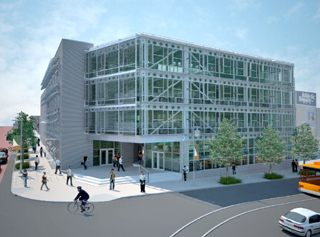
Weber + Thompson
Specialty: Architecture, planning, interior design, landscape architecture
Management: Blaine Weber, Scott Thompson, Kristen Scott
Year founded: 1987
Headquarters: Seattle
2006 revenues: $9.7 million
Projected 2007 revenues: $10.5 million
Current projects: Colman Center, a 13-story office tower near the Colman ferry dock; Fifteen Twenty-One Second Avenue, a luxury condo tower above the Pike Place Market; Ava, 240 residential units above a five-star boutique hotel at Eighth Avenue and Pine Street; Woodinville Wine Village, a 20-acre urban village where condos, restaurants, retail shops and wineries co-exist

Image by Weber + Thompson Weber + Thompson plans to move March 2008 into its new headquarters in the Terry Avenue Office Building. The 40,000-square-foot building was designed to achieve LEED gold for its shell and core, and LEED platinum for its interior.
|
Weber + Thompson has been taking growth hormones lately. In the firm’s first management change in two decades, it promoted nine staffers to principal in the last year, bringing its total roster of principals to 12.
In addition, early next year the company plans to move into new headquarters in South Lake Union designed by founding principal Scott Thompson. Aiming for LEED gold, the new building will have natural ventilation and a center courtyard which acts as a chimney, eliminating the need for air conditioning.
Construction bust coming
Meanwhile Seattle’s building industry, which has been experiencing five years of boom, is finally looking at bust. Many architecture firms downsize in a recession, but Weber + Thompson is hoping to avoid staff cuts and even to keep growing by expanding into other parts of the country.
“Often times, our clients take us to other markets,” said principal Liz Holland. Those markets include Sun Valley, Idaho, where the firm has several projects including Sweetwater, a planned development which could be one of the first communities in the U.S. to receive the new LEED for neighborhood development certification.
Founding principal Blaine Weber also expects to continue designing high-rise buildings, which he calls his “passion in life.” Weber applauds the city of Seattle for its new downtown zoning code, which requires developers to shoot for silver LEED if they want to build over 290 feet.
“That was a very bold move,” Weber said. “Very forward thinking.”
Thin buildings
The city’s code also requires buildings to be thinner. While that makes them look more graceful, he said, it also presents technical challenges for the designer.
“When you have a taller, more slender structure you have less area to work with and the structural system needs to be thoughtfully conceived,” Weber said.
It’s harder to make these buildings pencil out because you can’t have as many units per floor as you would in a traditional building.
“The efficiency ratios go out the window,” he said.
Another challenge is complying with the energy code, since so many of these high-rises have floor-to-ceiling glass. “It’s something that buyers are generally looking for, spectacular views and lots of light,” Weber said.
The firm is using very high-tech glass products and is working closely with energy consultants and mechanical engineers to find new ways to super-insulate, Weber said.